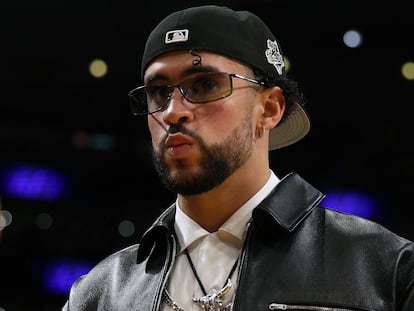The case of Bad Bunny: What’s the point of deleting your entire Instagram history?
The Puerto Rican artist recently emptied his account, something increasingly common among users of the social network: some do it to cancel the past, others to make a fresh start and some to create expectation

In a recent interview published in EL PAÍS, philosopher Margot Rot confessed that she would never show anyone her web browsing history, because all of “her soul, her psyche” is on display there. Considering this analogy, we might be overstepping the boundaries of privacy by asking Luján, a 25-year-old girl from Málaga, Spain, to tell us what is inside her Instagram archive. “That’s a long answer! You’re talking to a person that has been using Instagram since 2013. I have thousands of photos archived. Give me a moment and I will answer you,” she replies via WhatsApp. Social networks facilitate the creation, alteration and selective deletion of our digital identity, and frequently, detaching from the past begins with deleting certain posts from our profiles. Or, in more drastic situations, deleting the entire profile altogether, a trend has recently become popular with artists like Bad Bunny, Quevedo, C. Tangana and Justin Timberlake taking that extreme measure.
But Instagram is not the only platform where users reshape their digital footprint. Nowadays, there is probably no clearer sign of the end of a relationship than helplessly watching the photo of our former partner slowly descend in the WhatsApp screen, buried under a ton of irrelevant conversations. Some choose to archive that chat, with the risk of missing a possible message from that person. Others prefer to delete it completely, and then there are those who go as far as blocking the number altogether.
When examining her personal Instagram archive — where she stores the posts that she has removed from her public profile — Luján sees that she has approximately 200 photographs. She identifies as an active user on the platform, with a main focus on musical content. “I mostly found pictures of records, low-quality videos of concerts, tickets; just me showing off all the music I consumed,” she explains via voice message. Although, of course, many more things have ended up in her archive. “First of all, the Instagram of 2013 has nothing to do with the current one,” she states. “At first, it was a fairly basic application, limited to sharing posts with hashtags and not much else.” In her perception, in the past people used to post simple, less elaborate photos, with no deeper meaning. “It was a bit like: ‘I’m having chocolate milk? Well, here’s me posting that I’m having chocolate milk for breakfast.’ Just because.” Eventually, Luján began to leave these kinds of photos behind, as she tried to build a neater, more aesthetic, coherent profile. “I just found a photo I posted ages ago, which is simply my feet inside a camping tent. In 2014, that seemed like a good idea to me. Today I wouldn’t post that.”
Luján has also been removing contacts that are no longer part of her life from her Instagram profile. “After 10 years on the platform, there are many people with whom I no longer have a relation,” she explains. Still, although some of these relationships have ended, she does not contemplate the actual deletion of these photos. “They are people who have been part of my life, and I think: well, there they are.” This includes her ex-partner, with whom she broke up a few months ago. “Since I’m not coming out of a messy or super toxic relationship, and he hasn’t done anything to make me hate or resent him, I didn’t feel the need to erase him from my life. So I archived him, because he’s someone I’m very fond of. I don’t think I’ll post them again, but I have them there, for the memories. I think I would regret it if I deleted them.”
The strategy of the stars
In the world of artists and celebrities, digital deletion has gained popularity, often as a marketing strategy. A notable recent example is Bad Bunny, one of Spotify’s most listened-to artists, who recently deleted all his posts from Instagram (where he has 46 million followers) and changed his username to Benito, his real name. For the relief of his fans, however, a week ago he uploaded a new photo in which he appeared peacefully enjoying a bowl of breakfast cereal — accompanied by a sizeable wad of bills. Then, a few days ago, he shared a second publication with a series of photos and videos from his recent time in Puerto Rico. This is not the first time that Bad Bunny decides to start over on social media: two years ago, he welcomed 2022 by deleting all the content from his official Instagram profile, and in 2020, a simple “Bye, I’m gone” announced an absence that lasted three months.
This digital deletion strategy, of which singer Maluma was an early adopter, has also been recently put into practice by Justin Timberlake and the Spanish rapper Quevedo, who deleted all the publications from his account. C. Tangana did the exact same thing just before becoming El Madrileño. The list is long and also includes Dua Lipa — who last year abandoned her Instagram account — as well as singers Marc Anthony and Liam Payne.
Amel Fernández, social media specialist and ChatGPT expert, explains that this measure seeks to “generate hype.” What these artists seek, he points out, is to capture the attention of the moment, create suspense and make people talk about them in order to achieve a media rebirth. This approach, that attracts attention and generates reach, is usually meticulously planned, right down to the exact moment of return. Despite being a widely imitated strategy, Fernández states that it is still effective, because “everything that challenges the user’s usual perception continues to operate.” He also does not rule out the possibility that this digital transformation may often be driven by emotional motivations, or by a saturation point in the use of social media. “During the pandemic, many content creators suffered the consequences of confinement, deleted their profiles and, in many cases, never reopened them.”
Growing up, also on Instagram
A common motivation for many users to delete or archive large portions of their social media posts is the intention to project a more professional image. This was the case of Sara González, a 26-year-old interior designer who at the end of last summer archived her more than two hundred posts. This change coincided with the opening of her own interior design studio. “My goal was to associate my personal brand with the name of my company,” she explains. Sara noticed that some photos were not suitable for a professional context. “I realized I had a lot of photos where I appeared almost naked,” she recalls, candidly. “Oh, and because I had a boob job. I had a lot of photos in which the change was very noticeable, and I didn’t want to show those.”
Younger generations, even pre-Z, have a different relationship with social media posts. “There is a growing inclination towards ephemeral publications, such as stories, to the detriment of permanent posts in the feed. This reflects a preference for immediacy and spontaneity in digital communication,” explains Fernández. He adds: “This trend seems to have been initially driven by influencers and public figures that began to keep accounts with zero posts.” This reflects a shift in the perception of permanence in the digital world, where users may prefer to leave a lighter, more controlled digital footprint.
Sign up for our weekly newsletter to get more English-language news coverage from EL PAÍS USA Edition
Tu suscripción se está usando en otro dispositivo
¿Quieres añadir otro usuario a tu suscripción?
Si continúas leyendo en este dispositivo, no se podrá leer en el otro.
FlechaTu suscripción se está usando en otro dispositivo y solo puedes acceder a EL PAÍS desde un dispositivo a la vez.
Si quieres compartir tu cuenta, cambia tu suscripción a la modalidad Premium, así podrás añadir otro usuario. Cada uno accederá con su propia cuenta de email, lo que os permitirá personalizar vuestra experiencia en EL PAÍS.
¿Tienes una suscripción de empresa? Accede aquí para contratar más cuentas.
En el caso de no saber quién está usando tu cuenta, te recomendamos cambiar tu contraseña aquí.
Si decides continuar compartiendo tu cuenta, este mensaje se mostrará en tu dispositivo y en el de la otra persona que está usando tu cuenta de forma indefinida, afectando a tu experiencia de lectura. Puedes consultar aquí los términos y condiciones de la suscripción digital.
More information
Archived In
Últimas noticias
Most viewed
- Sinaloa Cartel war is taking its toll on Los Chapitos
- Oona Chaplin: ‘I told James Cameron that I was living in a treehouse and starting a permaculture project with a friend’
- Reinhard Genzel, Nobel laureate in physics: ‘One-minute videos will never give you the truth’
- Why the price of coffee has skyrocketed: from Brazilian plantations to specialty coffee houses
- Silver prices are going crazy: This is what’s fueling the rally











































